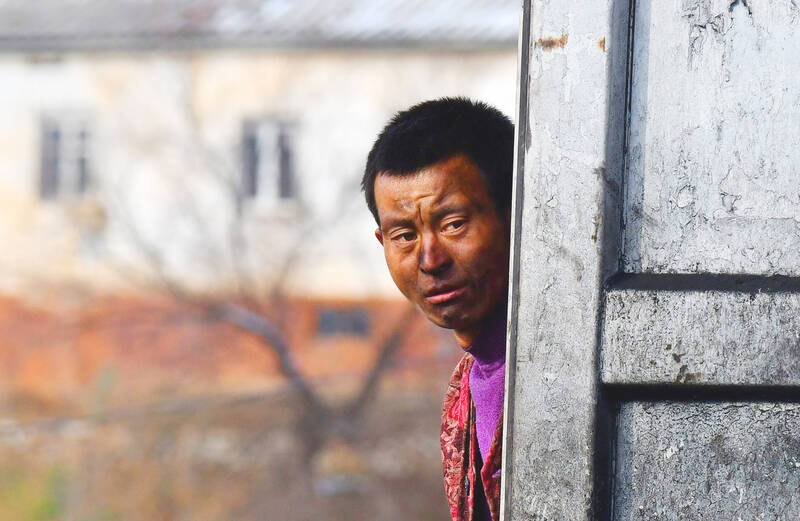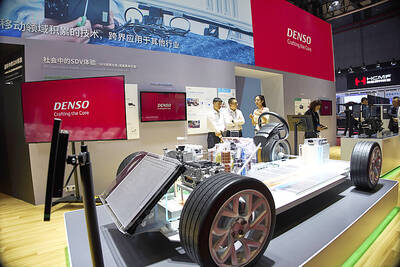Hundreds of meters underground, Emylbek Umarov hacked out lumps of coal by hand with a pickaxe in a dank mine in a remote mountainous corner of Kyrgyzstan.
Coal might be falling out of favor elsewhere because of climate change, but Suluktu’s mines hope growing demand from neighboring Central Asian countries and beyond would help them return to their Soviet heyday.
For some, like Umarov, the mine is one of the few places offering work — despite the threat of accidents that have killed dozens of people in the area in the past few years.

Photo: AFP
“It’s terrifying, it’s tough, but there’s no other work here,” said the 27-year-old, who has two degrees in computing and economics.
As he spoke, the coughing of miners with blackened faces echoed through the tunnels illuminated by a few lamps hanging from a ceiling dripping with water.
The men work with jackhammers, pickaxes and explosives on 12-hour shifts day or night 15 days a month for a monthly salary of less than 150 euros (US$159).

Photo: AFP
Before starting their shifts, they have to travel an hour to the mine in large Russian-made Kamaz trucks along a badly rutted road.
The hulks of Soviet-era machinery could be seen in the pinkish dawn.
Tucked away in the mountains, the town of Suluktu was founded in 1868 and is one of the oldest coal extraction hubs in Central Asia.

Photo: AFP
From the “miner’s bread” on sale in local bakeries to the local soccer team called “Shakhtar” (Miner) — everything in the town is a reminder of its main industry, including the coal dust coating the ground.
The town “heated Central Asia during Soviet times,” Suluktu Mayor Maksat Kadyrkulov said.
Like settlements across the former Soviet Union, it suffered from deindustrialization after its collapse, leading to a sharp drop in population and coal output.
“There is no farmland here. We just dig coal and there is no family without a miner,” Kadyrkulov said.
The mayor said he hoped Suluktu would recover its “past glory” thanks to growing demand for coal.
The Soviet era is a constant presence in the town.
On its outskirts stands a monument depicting two miners with a 4m-high hammer and sickle.
Trucks filled with coal file past the statues on their way to deliver their cargo to Uzbekistan and beyond since access to nearby Tajikistan is now closed off because of a flare-up of tensions along the border.
A mosaic nearby extols the glory of Soviet power, showing a miner with a red star behind him.
Before “we were proud to be miners,” said 64-year-old Nimadjan Abdulayevich, who spent 37 years in the mines, his voice hoarse from throat cancer.
While there have been no fatal accidents in the mine where Umarov works, the risk is constant.
“The mine is like a second front. You risk dying there,” is a phrase that miners often repeat.
Last year, the metal bars holding up the vein where Umarov was working collapsed, breaking his leg.
“Since then, the fear remains,” he said.
His father Dzhumbai, who now works on the surface as a welder, was caught up in a similar accident.
Mine director Kanynbek Ismailov said he lacked the resources for new equipment, even though the conditions in the mine are among the best of the 40 or so in Suluktu.
“We do everything by hand. We do not have new equipment,” Ismailov said.

GROWING OWINGS: While Luxembourg and China swapped the top three spots, the US continued to be the largest exposure for Taiwan for the 41st consecutive quarter The US remained the largest debtor nation to Taiwan’s banking sector for the 41st consecutive quarter at the end of September, after local banks’ exposure to the US market rose more than 2 percent from three months earlier, the central bank said. Exposure to the US increased to US$198.896 billion, up US$4.026 billion, or 2.07 percent, from US$194.87 billion in the previous quarter, data released by the central bank showed on Friday. Of the increase, about US$1.4 billion came from banks’ investments in securitized products and interbank loans in the US, while another US$2.6 billion stemmed from trust assets, including mutual funds,

AI TALENT: No financial details were released about the deal, in which top Groq executives, including its CEO, would join Nvidia to help advance the technology Nvidia Corp has agreed to a licensing deal with artificial intelligence (AI) start-up Groq, furthering its investments in companies connected to the AI boom and gaining the right to add a new type of technology to its products. The world’s largest publicly traded company has paid for the right to use Groq’s technology and is to integrate its chip design into future products. Some of the start-up’s executives are leaving to join Nvidia to help with that effort, the companies said. Groq would continue as an independent company with a new chief executive, it said on Wednesday in a post on its Web

Even as the US is embarked on a bitter rivalry with China over the deployment of artificial intelligence (AI), Chinese technology is quietly making inroads into the US market. Despite considerable geopolitical tensions, Chinese open-source AI models are winning over a growing number of programmers and companies in the US. These are different from the closed generative AI models that have become household names — ChatGPT-maker OpenAI or Google’s Gemini — whose inner workings are fiercely protected. In contrast, “open” models offered by many Chinese rivals, from Alibaba (阿里巴巴) to DeepSeek (深度求索), allow programmers to customize parts of the software to suit their

JOINT EFFORTS: MediaTek would partner with Denso to develop custom chips to support the car-part specialist company’s driver-assist systems in an expanding market MediaTek Inc (聯發科), the world’s largest mobile phone chip designer, yesterday said it is working closely with Japan’s Denso Corp to build a custom automotive system-on-chip (SoC) solution tailored for advanced driver-assistance systems and cockpit systems, adding another customer to its new application-specific IC (ASIC) business. This effort merges Denso’s automotive-grade safety expertise and deep vehicle integration with MediaTek’s technologies cultivated through the development of Media- Tek’s Dimensity AX, leveraging efficient, high-performance SoCs and artificial intelligence (AI) capabilities to offer a scalable, production-ready platform for next-generation driver assistance, the company said in a statement yesterday. “Through this collaboration, we are bringing two